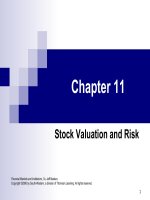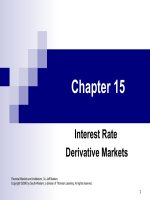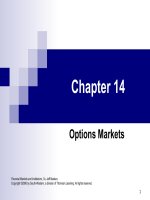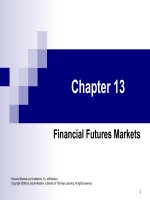Tài liệu Thị trường tài chính và các định chế tài chính_ Chapter 05 pdf
Bạn đang xem bản rút gọn của tài liệu. Xem và tải ngay bản đầy đủ của tài liệu tại đây (308.24 KB, 36 trang )
1
Chapter 5
Monetary Theory and Policy
Financial Markets and Institutions, 7e, Jeff Madura
Copyright ©2006 by South-Western, a division of Thomson Learning. All rights reserved.
2
Chapter Outline
Monetary theory
Tradeoff faced by the Fed
Economic indicators monitored by the Fed
Lags in monetary policy
Assessing the impact of monetary policy
Integrating monetary and fiscal policies
Global effects of monetary policy
3
Monetary Theory
Pure Keynesian Theory
One of the most popular theories influencing the Fed
Developed by John Maynard Keynes
Suggests how the Fed can affect the interaction
between the demand for money and the supply of
money to influence:
Interest rates
The aggregate level of spending
Economic growth
4
Monetary Theory (cont’d)
Pure Keynesian Theory (cont’d)
Can be explained by using the loanable funds
framework
Demand for and supply of loanable funds
determine the equilibrium interest rate
The business investment schedule illustrates the
inverse relationship between interest rates on
loanable funds and the level of business
investment
5
Monetary Theory (cont’d)
Pure Keynesian Theory (cont’d)
Correcting a weak economy
The Fed would use open market operations to increase the
money supply
A higher level of the money supply would reduce interest
rates
Lower interest rates encourage more borrowing and
spending
Keynesian philosophy advocates an active role for the
government in correcting economic problems
6
Monetary Theory (cont’d)
S
2
Correcting a Weak Economy
D
1
i
2
i
1
S
1
Demand and Supply of Loanable Funds
Business Investment Schedule
i
1
i
2
B
1
B
2
7
Monetary Theory (cont’d)
Pure Keynesian Theory (cont’d)
Correcting high inflation
The Fed would sell Treasury securities (decrease
the money supply)
A lower level of the money supply reduces the
level of spending
Less spending slows economic growth and
reduces inflationary pressure (demand-pull
inflation)
8
Monetary Theory (cont’d)
S
1
Correcting High Inflation
D
1
i
1
i
2
S
2
Demand and Supply of Loanable Funds
Business Investment Schedule
i
2
i
1
B
2
B
1
9
Monetary Theory (cont’d)
Pure Keynesian Theory (cont’d)
Effects of a credit crunch on a stimulative policy
The economic impact of monetary policy depends on the
willingness of banks to lend funds
If banks are unwilling to extend credit despite a stimulative
policy, the result is a credit crunch
A credit crunch can occur during a restrictive policy since
some borrowers will not borrow because of the high interest
rates
10
Monetary Theory (cont’d)
Quantity Theory and the Monetarist approach
The quantity theory suggests a particular relationship
between the money supply and the degree of economic
activity in the equation of exchange:
Velocity is the average number of times each dollar
changes hands per year
The right side of the equation is the total value of goods
and services produced
If velocity is constant, a change in the money supply will
produce a predictable change in the total value of goods
and services
QPMV
G
=
11
Monetary Theory (cont’d)
Quantity Theory and the Monetarist approach
(cont’d)
An early form of the theory assumed a constant Q
Assumes a direct relationship between the money supply
and prices
Under the modern quantity theory of money,
the constant quantity assumptions has been
relaxed
A direct relationship exists between the money supply
and the value of goods and services
12
Monetary Theory (cont’d)
Quantity Theory and the Monetarist approach
(cont’d)
Velocity represents the ratio of money stock to
nominal output
Velocity is affected by any factor that influences
this ratio:
Income patterns
Factors that change the ratio of households’ money
holdings to income
Credit cards
Inflationary expectations
13
Monetary Theory (cont’d)
Comparison of the Monetarist and Keynesian
Theories
The Monetarist approach advocates stable, low
growth in the money supply
Allows economic problems to resolve themselves
Keynesian approach would call for a loose
monetary policy to cure a recession
14
Monetary Theory (cont’d)
Comparison of the Monetarist and Keynesian
Theories (cont’d)
Monetarists are concerned about maintaining low
inflation and are willing to tolerate a natural rate of
unemployment
Keynesians focus on maintaining low
unemployment and are willing to tolerate any
inflation that results from stimulative monetary
policies
15
Monetary Theory (cont’d)
Theory of Rational Expectations
Holds that the public accounts for all existing information
when forming its expectations
Suggests that households and business will use historical
effects of monetary policy to forecast the impact of an
existing policy and act accordingly
Households spend more with a loose monetary policy to avoid
inflation
Businesses will increase their investment with a loose
monetary policy to avoid higher costs
Labor market participants will negotiate higher wages with a
loose monetary policy
Supports the Monetarist view that changes in monetary
policy do not have a sustained impact on the economy
16
Monetary Theory (cont’d)
Which theory is correct?
The FOMC recognizes the virtues and limitations
of each theory
The FOMC adjusts monetary growth targets to control
economic growth, inflation, and unemployment
Recognizing the Monetarist view, the FOMC is
concerned about the inflation resulting from a loose
monetary policy
17
Tradeoff Faced by the Fed
Ideally, the Fed would like:
Low inflation
Steady GDP growth
Low unemployment
There is a negative relationship between
unemployment and inflation
Phillips curve
A tight money policy can curb inflation but increase
unemployment and vice versa
18
Tradeoff Faced by the Fed (cont’d)
Impact of other forces on the tradeoff
Cost factors such as energy costs and
insurance costs can influence the tradeoff
When both inflation and unemployment are
high, Fed members may disagree as to the
type of monetary policy that should be
implemented
19
Tradeoff Faced by the Fed (cont’d)
Impact of other forces on the tradeoff (cont’d)
How the Fed’s focus shifted during the Persian Gulf War
There were numerous indications of a possible recession in the
summer of 1990
The abrupt increase in oil prices placed upward pressure on U.S.
inflation
How the Fed’s emphasis shifted during 2001–2004
The focus shifted from high inflation to the weak economy over time
From January to December 2001, the FOMC reduced the targeted
federal funds rate ten times
In 2002 and 2003, the Fed reduced the federal funds target rate
twice
20
Economic Indicators Monitored by
the Fed
Indicators of economic growth
Gross domestic product (GDP)
Measures the total value of goods and services
produced
Measured each month
The most direct indicator of economic growth
Level of production
A high level indicates strong economic growth and
can result in increased demand for labor
21
Economic Indicators Monitored by
the Fed (cont’d)
Indicators of economic growth (cont’d)
National income
The total income earned by firms and individual employees
A strong demand for goods and services results in a large
amount of income
Unemployment rate
Does not necessarily indicate the degree of economic growth
Can decrease in weak economic growth periods if new jobs
are created
22
Economic Indicators Monitored by
the Fed (cont’d)
Indicators of economic growth (cont’d)
Industrial production index
Retail sales index
Home sales index
Composite index
Consumer confidence surveys
23
Economic Indicators Monitored by
the Fed (cont’d)
Indicators of inflation
Producer and consumer price indexes
The PPI measures prices at the wholesale level
The CPI measures prices on the retail level
Both indexes are used to forecast inflation
Agricultural and housing price indexes also exist
Other indicators
Wages, oil prices, transportation costs, the price of
gold, indicators of economic growth
24
Economic Indicators Monitored by
the Fed (cont’d)
How the Fed uses indicators
The Fed uses indicators to anticipate how
economic conditions will change and then
determines what monetary policy would be
appropriate
Weak economic conditions suggest an
expansionary monetary policy
High productivity and employment suggest a
restrictive monetary policy
25
Economic Indicators Monitored by
the Fed (cont’d)
Index of Leading Economic Indicators
The Conference Board publishes indexes of leading,
coincident, and lagging economic indicators
Leading economic indicators are used to predict future
economic activity
Three consecutive monthly changes in the same direction
suggest a turning point in the economy
Coincident economic indicators reach their peaks and
troughs at the same time as business cycles
Lagging economic indicators tend to rise or fall a few
months after business-cycle expansions and contractions









